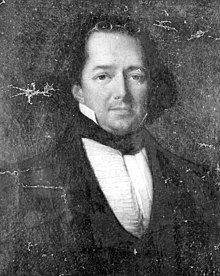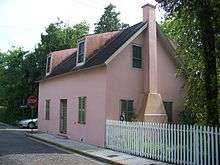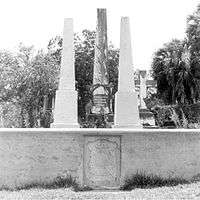Prince Achille Murat
Charles Louis Napoleon Achille Murat (known as Achille, 21 January 1801 – 15 April 1847) was the eldest son of Joachim Murat, the brother-in-law of Napoleon who was appointed King of Naples during the First French Empire. After his father was deposed and executed by his own subjects, Achille Murat went into exile in Austria with his siblings and mother.
| Achille Murat | |
|---|---|
 | |
| Prince Murat | |
| Tenure | 13 October 1815 – 15 April 1847 |
| Predecessor | Prince Joachim |
| Successor | Prince Lucien |
| Born | 21 January 1801 Paris, France |
| Died | 15 April 1847 (aged 46) Jefferson County, Florida, U.S. |
| Spouse | Catherine Willis Gray |
| Father | Joachim Murat |
| Mother | Caroline Bonaparte |
At the age of 21, Achille Murat emigrated to the United States and settled at St. Augustine, Florida, becoming a naturalized citizen sometime after July 1828 and dropping his European titles.
Early life

Achille Murat was born in the Hôtel de Brienne in Paris, France. His father was Joachim Murat, the son of an affluent farmer and innkeeper,[1] who became one of Napoleon's loyal followers. Joachim Murat was appointed Marshal of France for his military service, and was later awarded royal positions by Napoleon under the First French Empire, including the throne of the Kingdom of Naples.
Achille's mother was Caroline Bonaparte, sister of Napoleon. She was styled Grand Duchess of Berg and Queen of Naples, while Achille was considered the crown prince.
Murat's governess was Catherine Davies from Anglesey in Wales. In 1841 she published a memoir describing her eleven years' service with the Murat family.[2]
Exile in Austria and emigration to the United States
After Napoleon was exiled for a second time in 1815, Joachim Murat was deposed and executed by his subjects.[3] Young Achille and his siblings were taken by their mother into exile at the castle of Frohsdorf,[4] near Vienna in Lower Austria. When Murat turned twenty-one, he obtained permission to emigrate to America.[5]
In 1821 he embarked from a Spanish port bound for the United States. On arrival in New York, Murat immediately applied for naturalization.[6] After a few months in that city he made an extensive tour through the United States, using an assumed name at first. He had a striking resemblance to his famous uncle in countenance and mannerisms. Although he had renounced all his European titles[7] and citizenship, his wide social connections brought Murat to Washington, where he befriended Richard Keith Call,[8] Florida's territorial delegate to the Congress.

On the Florida frontier
Call told Murat of opportunities in the new territory of Florida, which had been acquired by the United States from Spain in 1821.[9] In the spring of 1824, the former "Prince of Naples" settled in St. Augustine,[10] reputedly renting what is now called the Prince Murat House on St. George Street.[11] Murat soon became active in St. Augustine society by joining the Masonic lodge and dabbling in local politics.[12] He enrolled in the local militia and was briefly a volunteer under the command of his personal friend, Brig. Gen. Joseph Hernández.
Murat purchased an extensive property of 2,800 acres (1,100 ha) and built a plantation where he planted orange groves, sugar cane, cotton, and tobacco. He named it 'Parthenope', in honor of his onetime principality in Naples, Italy, which had been founded on the site of the ancient Greek colony of Parthenope (see History of Naples).
Murat's Parthenope was located about ten miles south of St. Augustine on the west side of the Matanzas River, at the mouth of Moses Creek. Murat liked to go nude and made a submersible chair to escape the heat of the north Florida summers, using it to sit naked in the waters of Moses Creek with mosquito netting over his head.[13] A neighbor observed that he was obsessed with the "...eatibility of the whole animal tribe." Murat was known to have experimented with eating baked turkey buzzard,[14] boiled owl, roasted crow, stewed alligator,[15] lizards and rattlesnakes. He had an aversion to baths, didn't like to change his clothes, "washed his feet only after he wore out his shoes," and slept on a mattress stuffed with Spanish moss.[16]
Around 1825, Murat bought the land he would call Lipona Plantation, 15 miles (24 km) east of Tallahassee. He lived there during the remainder of Florida's territorial and early statehood days. The name Lipona is an anagram of "Napoli" (Naples), the kingdom where Murat once thought he would succeed his father. He purchased Lipona at the prodding of the Marquis de Lafayette,[17] beneficiary of the Lafayette Land Grant of July 4, 1825, which had granted him (LaFayette) 36 square miles (93 km2) of land[18] near what would become the city of Tallahassee.
Many authors have repeated claims that Murat was an elected alderman of Tallahassee in 1824, mayor in 1825, and its longest-serving postmaster (1826–1838).[19] The public record and historical evidence do not support these assertions.[20] This and other misinformation about Murat appeared as early as 1888 in Appletons' Cyclopædia of American Biography[21] and was repeated in an 1890s tourists' "guide book" published by the Murat estate (i.e., Bellevue Plantation) that overstated Murat's involvement in local politics; the guide book is mentioned in Bradford Torrey's 1895 book entitled A Florida Sketch-Book, which recalls Torrey's 1893 visit to the Murat estate near Tallahassee.[22] Torrey wrote that Catherine Murat's neighbor and another local "indisputable citizen"—a judge—refuted the Murat claims published in the tourist's guidebook. Because the original city charter for the city of Tallahassee was not in effect until December 9, 1825 and the first municipal election was not held until January 2, 1826, there was no city council in existence in 1824 or 1825; thus Murat could not have been an alderman or mayor in those years.[23] Federal records show Isham G. Searcy as the federally appointed postmaster of Tallahassee for the period claimed in the Murat estate guide-book.[24]
Legend tells that the Marquis' agents arranged for a group of fifty or sixty Norman French farmers to settle on the land around 1831, but there is no documentation of this taking place.[25]
Murat met Catherine Daingerfield Willis Gray in 1826 and married her on July 12 of that year at Tallahassee, Florida. They did not have any children. Gray was the great-grandniece of George Washington.
Murat's political sympathies seem to have been Jacksonian throughout his time in Florida. At a political rally in 1826, he called one of the candidates, his neighbor David Betton Macomb, a "turncoat";[26] Macomb had led a toast to Kentucky statesman Henry Clay on at least one occasion that summer (an alternative version of the story has Macomb upset that Murat's slaves were stealing his hogs). Macomb and Murat met at a local dueling ground near Hiamones Lake. Murat's shot went through Macomb's shirt without touching flesh, and Macomb's took off half of the little finger of Murat's right hand.[26]
During the early phase of the Seminole Wars, and for the previous three years, Murat was a lieutenant colonel of Florida's militia and sometime aide to Brig. Gen. Richard Keith Call. He would retain the rank of colonel the rest of his life.[27]
Friendship with Ralph Waldo Emerson
In the winter of 1826, during one of his periodic visits to St. Augustine, Murat met the American writer Ralph Waldo Emerson.[28][29] The two became close friends and enjoyed discussing topics of the day as well as politics, society, and history. Of Murat, Emerson wrote:
- A new event is added to the quiet history of my life. I have connected myself by friendship to a man ... with as ardent a love of truth as that which animates me, with a mind that surpasses mine in the variety of its research, & sharpened & strengthened to an energy for action to which I have no pretension by advantages of birth & practical connection with mankind beyond almost all men in the world.[30]
Like his contemporary, Alexis de Tocqueville, Murat was one of the first notable essayists on culture and mores in the new republic of the United States.[31] During his residence at his plantation near St. Augustine, Murat began to write[32] his observations on American politics and his daily life in Florida in fluent French, Italian and English.[33] He wrote on slavery, economics, and literature as well, but his books never caught on with the public. Murat was a staunch defender of slavery[34] although he professed to fight for human liberty.[35]
To Europe and back

Following the July Revolution of 1830 in France, Murat returned to Europe, where he was assigned to the command of a regiment of the Belgian Legion.[36] While in Belgium and France, he hoped to regain some part of the family fortune based on the properties of his parents. His attempts were futile, and in 1834 the Murats returned to the Tallahassee area.
In 1835, Murat and his wife moved to Louisiana,[37] where he had purchased a sugarcane plantation outside New Orleans and a town house in the city. The couple lived there for several years while he practiced law without much success.[38] After their return to Florida, Murat mortgaged the Lipona property to the Tallahassee Union Bank. He lost it in 1839 when he could no longer meet his financial obligations as a result of the delayed effects of the financial recession of 1837. He and his wife were forced to move to a smaller plantation they named Econchatti, in present-day Jefferson County, Florida.[39] Murat died there in 1847,[40] and was buried in the St. John's Episcopal Church cemetery in Tallahassee.
Murat's maternal first cousin, Napoleon III of France, provided his widow with a cash sum of $40,000 and an annual stipend so that she could live the life to which she had become accustomed. She proved to be a better handler of money than her husband had been,[41] and purchased the Bellevue Plantation in 1854.[40] She held court among her friends and admirers until after the Civil War. Catherine Murat died in 1867 and was also buried at the St. Johns Episcopal Church cemetery. In 1967, the Bellevue plantation house was moved to Tallahassee, where it has been made part of the Tallahassee Museum.[42]
Ancestry
| Ancestors of Prince Achille Murat | ||||||||||||||||||||||||||||||||||||||||||||||||||||||||||||||||||||||||||||||||||||||||||||||||||||||||||||||||||||||||||||||||||||||||||||||||||||||||||||||||||||||||||||||||||||||||||||||||||||||||||||||||||||||||||||||||||||||||||||||||||||||||||||||||||||||||||||||||||||||||||||||||||||||||||||||||||||||||||||||||||||||||||||||||||||||||||||||||||||||||||||||||||||||||||||||||||||||||||||||||||||||||||||||||||||||||||||||||||||||||||||||||||||||||||||||||||||||||||||||||||||||||||||||||||||||||||||||||||||||||||||||||||||||||||||||||||||||||||||||||||||||||||||||||||||||||||||||||
|---|---|---|---|---|---|---|---|---|---|---|---|---|---|---|---|---|---|---|---|---|---|---|---|---|---|---|---|---|---|---|---|---|---|---|---|---|---|---|---|---|---|---|---|---|---|---|---|---|---|---|---|---|---|---|---|---|---|---|---|---|---|---|---|---|---|---|---|---|---|---|---|---|---|---|---|---|---|---|---|---|---|---|---|---|---|---|---|---|---|---|---|---|---|---|---|---|---|---|---|---|---|---|---|---|---|---|---|---|---|---|---|---|---|---|---|---|---|---|---|---|---|---|---|---|---|---|---|---|---|---|---|---|---|---|---|---|---|---|---|---|---|---|---|---|---|---|---|---|---|---|---|---|---|---|---|---|---|---|---|---|---|---|---|---|---|---|---|---|---|---|---|---|---|---|---|---|---|---|---|---|---|---|---|---|---|---|---|---|---|---|---|---|---|---|---|---|---|---|---|---|---|---|---|---|---|---|---|---|---|---|---|---|---|---|---|---|---|---|---|---|---|---|---|---|---|---|---|---|---|---|---|---|---|---|---|---|---|---|---|---|---|---|---|---|---|---|---|---|---|---|---|---|---|---|---|---|---|---|---|---|---|---|---|---|---|---|---|---|---|---|---|---|---|---|---|---|---|---|---|---|---|---|---|---|---|---|---|---|---|---|---|---|---|---|---|---|---|---|---|---|---|---|---|---|---|---|---|---|---|---|---|---|---|---|---|---|---|---|---|---|---|---|---|---|---|---|---|---|---|---|---|---|---|---|---|---|---|---|---|---|---|---|---|---|---|---|---|---|---|---|---|---|---|---|---|---|---|---|---|---|---|---|---|---|---|---|---|---|---|---|---|---|---|---|---|---|---|---|---|---|---|---|---|---|---|---|---|---|---|---|---|---|---|---|---|---|---|---|---|---|---|---|---|---|---|---|---|---|---|---|---|---|---|---|---|---|---|---|---|---|---|---|---|---|---|---|---|---|---|---|---|---|---|---|---|---|---|---|---|---|---|---|---|---|---|---|---|---|---|---|---|---|---|---|---|---|---|---|---|---|---|---|---|---|---|---|---|---|---|---|---|---|---|---|---|---|---|---|---|---|---|---|---|---|---|---|---|---|---|---|---|---|---|---|---|---|---|---|---|---|---|---|---|---|---|---|---|---|---|---|---|---|---|---|---|---|---|---|---|---|---|---|---|---|---|---|---|---|---|---|---|---|---|---|---|---|---|---|---|---|---|---|---|---|---|---|---|---|---|---|---|---|---|---|---|---|---|---|---|---|---|---|---|---|---|---|---|---|---|---|---|---|---|---|---|---|---|---|---|---|---|---|---|---|---|---|---|---|---|---|---|---|
| ||||||||||||||||||||||||||||||||||||||||||||||||||||||||||||||||||||||||||||||||||||||||||||||||||||||||||||||||||||||||||||||||||||||||||||||||||||||||||||||||||||||||||||||||||||||||||||||||||||||||||||||||||||||||||||||||||||||||||||||||||||||||||||||||||||||||||||||||||||||||||||||||||||||||||||||||||||||||||||||||||||||||||||||||||||||||||||||||||||||||||||||||||||||||||||||||||||||||||||||||||||||||||||||||||||||||||||||||||||||||||||||||||||||||||||||||||||||||||||||||||||||||||||||||||||||||||||||||||||||||||||||||||||||||||||||||||||||||||||||||||||||||||||||||||||||||||||||||
References
- Ramsay Weston Phipps (1935). The Armies of the First French Republic and the Rise of the Marshals of Napoleon I ... 1. Oxford University Press, H. Milford. pp. 146–147. Retrieved 6 May 2013.
- William Roberts, ‘Davies, Catherine (b. 1773, d. in or after 1841)’, rev. J. Gilliland, Oxford Dictionary of National Biography, Oxford University Press, 2004 accessed 29 Nov 2014
- University of California Chronicle. University of California Press. 1921. p. 121. Retrieved 12 May 2013.
- Louise Pecquet du Bellet; Edward Jaquelin; Martha Cary Jaquelin (1907). Some prominent Virginia families. J.P. Bell company (inc.). p. 291. Retrieved 12 May 2013.
- Hezekiah Niles; William Ogden Niles; Jeremiah Hughes; George Beatty (1823). Niles' National Register: Containing Political, Historical, Geographical, Scientifical, Statistical, Economical, and Biographical Documents, Essays and Facts : Together with Notices of the Arts and Manufactures, and a Record of the Events of the Times. p. 226. Retrieved 6 May 2013.
- Niles' Weekly Register. s.n. 1823. p. 272. Retrieved 6 May 2013.
- Edgar Ewing Brandon (1944). A Pilgrimage of Liberty: A Contemporary Account of the Triumphal Tour of General Lafayette Through the Southern and Western States in 1825, as Reported by the Local Newspapers. Lawhead Press. p. 93. Retrieved 6 May 2013.
- Margaret Uhler (1 January 2003). The Floridians. iUniverse. p. 53. ISBN 978-0-595-26718-7. Retrieved 6 May 2013.
- Herbert J. Doherty (1961). Richard Keith Call, Southern Unionist. University of Florida Press. p. 30. Retrieved 6 May 2013.
- Charlton W. Tebeau (1971). A History of Florida. University of Miami Press. p. 134. ISBN 978-0-87024-149-9. Retrieved 6 May 2013.
- William R. Adams (15 March 2009). St. Augustine and St. Johns County: A Historical Guide. Pineapple Press Inc. p. 46. ISBN 978-1-56164-432-2. Retrieved 6 May 2013.
- Alfred Jackson Hanna (1946). A Prince in Their Midst: The Adventurous Life of Achille Murat on the American Frontier. University of Oklahoma Press. pp. 79–80. Retrieved 6 May 2013.
- Hanna 1946, p. 80
- Diane Roberts (1 November 2007). Dream State: Eight Generations of Swamp Lawyers, Conquistadors, Confederate Daughters, Banana Republicans, and Other Florida Wildlife. Free Press. p. 75. ISBN 978-1-4165-8957-0. Retrieved 6 May 2013.
- Ballou's Monthly Magazine. M. M. Ballou. 1856. p. 395.
- Gene M. Burnett (1 June 1996). Florida's Past: People and Events That Shaped the State. Pineapple Press Inc. p. 103. ISBN 978-1-56164-115-4. Retrieved 6 May 2013.
- Harry Gardner Cutler (1923). History of Florida: Past and Present, Historical and Biographical. Lewis Publishing Company. p. 528. Retrieved 6 May 2013.
- Creating an Old South: Middle Florida's Plantation Frontier before the Civil War. Univ of North Carolina Press. 2002. p. 95. ISBN 978-0-8078-6003-8. Retrieved 6 May 2013.
- William Thomas Cash (1938). The Story of Florida. American Historical Society, Incorporated. p. 401.
- William Thomas Cash (1938). The Story of Florida. American Historical Society, Incorporated. p. 401.
- James Grant Wilson; John Fiske, eds. (1888). Appleton's Cyclopædia of American Biography. D. Appleton. p. 462.
- Bradford Torrey (1895). A Florida Sketch-book. Houghton, Mifflin. p. 193.
- Mary Louise Ellis; William Warren Rogers (1986). Tallahassee & Leon County: A History and Bibliography. Historic Tallahassee Preservation Board, Florida Department of State. p. 18.
- Congressional Serial Set. U.S. Government Printing Office. 1844. p. 388.
- Julianne Hare (30 November 2006). Historic Frenchtown: Heart and Heritage in Tallahassee. The History Press. p. 28. ISBN 978-1-59629-149-2. Retrieved 6 May 2013.
- Andrew Forest Muir (January 1954). "David Betton Macomb, Frontiersman" (PDF). The Florida Historical Quarterly. 32 (3): 197. Retrieved 1 March 2016.
- "The Florida Militia's Napoleonic Connection". DMA.myflorida.com. Florida Department of Military Affairs. 31 May 2012. Retrieved 16 April 2018.
- Ralph Waldo Emerson (1909). Journals of Ralph Waldo Emerson: with annotations. Reprint Services Corp., 1998. p. 155. Retrieved 12 May 2013.
- Maurice York; Rick Spaulding (2008). Ralph Waldo Emerson: The Infinitude of the Private Man : a Biography. Lightning Source Incorporated. p. 47. ISBN 978-0-9801190-0-8. Retrieved 5 May 2013.
- Peter S. Field (2003). Ralph Waldo Emerson: The Making of a Democratic Intellectual. Rowman & Littlefield. p. 74. ISBN 978-0-8476-8843-2. Retrieved 5 May 2013.
- Alexis de Tocqueville (30 March 2009). Tocqueville on America After 1840: Letters and Other Writings. Cambridge University Press. p. 10. ISBN 978-0-521-85955-4. Retrieved 6 May 2013.
- Catalogue of rare and valuable autograph letters, historical documents and author's original manuscripts ... Pearson & Co. 1907. pp. 163–164. Retrieved 6 May 2013.
- Lema, Cassandra (November 2010). "A Guide to the Achille Murat Letters".
- Achille Murat (1833). The United States of North America. Effingham Wilson. p. 376. Retrieved 6 May 2013.
- James Silk Buckingham; John Sterling; Frederick Denison Maurice; et al., eds. (1833). The Athenaeum. J. Francis. p. 512.
- The Century Illustrated Monthly Magazine. Century Company. 1893. Retrieved 6 May 2013.
- Simone De La Souchére Deléry; Delery (30 April 1999). Napoleon's Soldiers in America. Pelican Publishing. p. 151. ISBN 978-1-58980-936-9. Retrieved 6 May 2013.
- Julianne Hare (1 April 2002). Tallahassee, Fl: A Capital City History. Arcadia Publishing. p. 39. ISBN 978-0-7385-2371-2. Retrieved 6 May 2013.
- Alfred Jackson Hanna (1946). A Prince in Their Midst: The Adventurous Life of Achille Murat on the American Frontier. University of Oklahoma Press. p. 216. Retrieved 6 May 2013.
- Bertram Hawthorne Groene (1971). Ante-bellum Tallahassee. Florida Heritage Foundation. p. 42. Retrieved 6 May 2013.
- Elswyth Thane (1966). Mount Vernon is Ours: The Story of Its Preservation. Duell, Sloan and Pearce. Retrieved 6 May 2013.
- Lewis N. Wynne; John T. Parks (1 July 2004). Florida's Antebellum Homes. Arcadia Publishing. p. 50. ISBN 978-0-7385-1617-2. Retrieved 6 May 2013.
External links
- Florida Letters of Achille Murat, available online from the University of Florida Digital Collections
- . Appletons' Cyclopædia of American Biography. 1900.
- . Encyclopædia Britannica (11th ed.). 1911. This article contains biographical information on Murat.
| French royalty of a French client state | ||
|---|---|---|
| New title | Hereditary Prince of Berg 1806–1808 |
Grand Duchy abolished in 1810 |
| New title | Crown Prince of Naples 1808–1815 |
Title abolished in 1816 |
| French nobility of the First French Empire | ||
| Preceded by Joachim Murat |
Prince Murat 1815–1847 |
Succeeded by Lucien Murat |